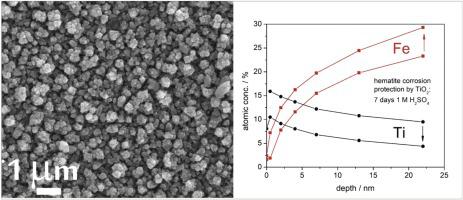Journal of Photochemistry and Photobiology A: Chemistry ( IF 4.1 ) Pub Date : 2021-01-09 , DOI: 10.1016/j.jphotochem.2020.113126 T. Imrich , R. Zazpe , H. Krýsová , Š. Paušová , F. Dvorak , J. Rodriguez-Pereira , J. Michalicka , O. Man , J.M. Macak , M. Neumann-Spallart , J. Krýsa

|
Iron (III) oxide, in the form of hematite (α-Fe2O3), is a n-type semiconductor which is photoactive in the visible spectral region. Therefore, use in photoelectrocatalysis and photoassisted water electrolysis may be suggested. For such implementations, stability of contacts with liquid phases is mandatory. Hematite is stable in alkaline media but less stable in acidic media. For the first time the coverage of porous photoactive Sn doped hematite by thin capping layers of TiO2, deposited by Atomic Layer Deposition (ALD) and its impact on photocurrent and chemical stability of hematite is shown. The nominal thicknesses of the TiO2 ALD coatings were 0.5, 2 and 7.5 nm. The presence of the TiO2 coatings was evidenced by X-ray photoelectron spectroscopy, high-resolution transmission electron microscopy (HR-TEM) and scanning TEM coupled with energy dispersive X-ray (EDX) spectroscopy. HR-TEM analyses revealed that the TiO2 capping layers were amorphous and conformal. Exposure of uncovered hematite layers to 1 M sulfuric acid led to a nominal dissolution rate of 0.23 nm/h which was halved when a TiO2 ALD coating (7.5 nm thin) was applied. Due to mismatch of the valence band positions of the two semiconductors, photocurrents were strongly diminished as the capping layer thickness was increased. Post-calcination of as deposited ALD films on hematite resulted in an increase of photocurrent, which only exceeded photocurrents of pristine hematite when the ALD thickness was not more than 0.5 nm.
中文翻译:

ALD-TiO 2封端保护赤铁矿光电极
氧化铁,在赤铁矿的形式(的α-Fe 2 ö 3),是一种n型半导体它是在可见光谱区的光活性。因此,可以建议在光催化和光辅助水电解中使用。对于这样的实施方式,与液相接触的稳定性是强制性的。赤铁矿在碱性介质中稳定,但在酸性介质中不稳定。首次显示了通过原子层沉积(ALD)沉积的TiO 2薄覆盖层对多孔光敏Sn掺杂的赤铁矿的覆盖及其对赤铁矿的光电流和化学稳定性的影响。TiO 2 ALD涂层的标称厚度为0.5、2和7.5 nm。TiO 2的存在X射线光电子能谱,高分辨率透射电子显微镜(HR-TEM)和扫描TEM与能量色散X射线(EDX)光谱相结合证明了镀层。HR-TEM分析表明,TiO 2覆盖层是无定形的和保形的。将未覆盖的赤铁矿层暴露于1 M硫酸导致标称溶出速率为0.23 nm / h,当TiO 2降低一半涂覆ALD涂层(7.5nm薄)。由于两个半导体的价带位置不匹配,随着覆盖层厚度的增加,光电流大大降低。在赤铁矿上沉积的ALD薄膜的后煅烧导致光电流增加,仅当ALD厚度不超过0.5 nm时才超过原始赤铁矿的光电流。











































 京公网安备 11010802027423号
京公网安备 11010802027423号